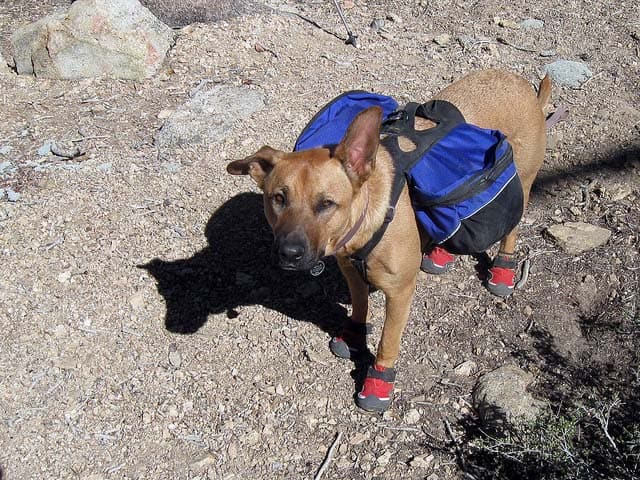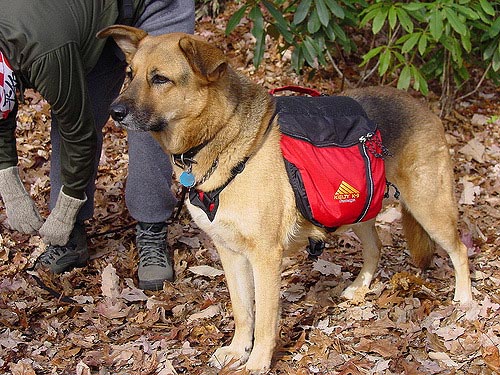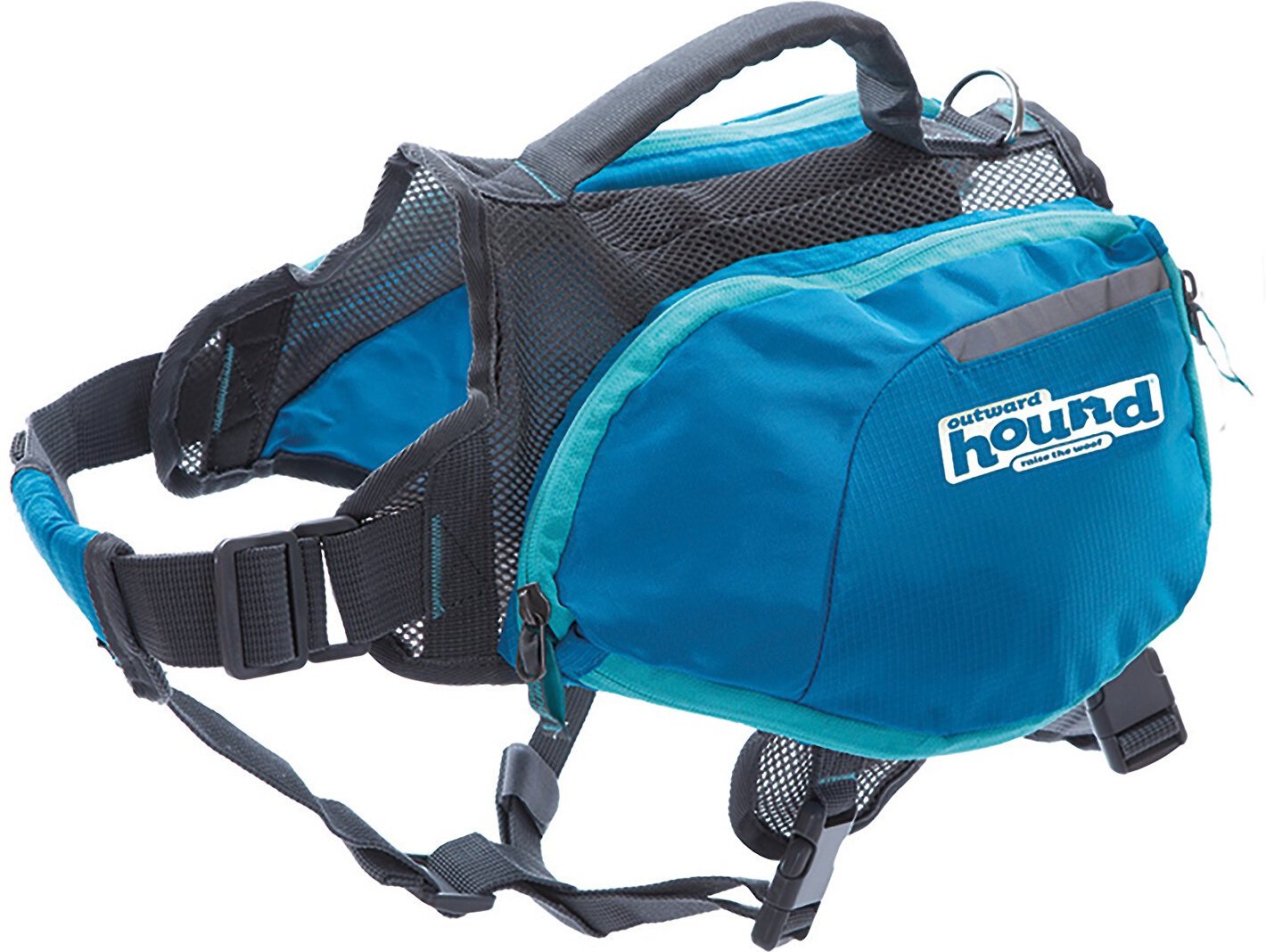Congratulations! You have a dog and the foresight to plan for its survival during an emergency.
Dog Bug Out Bag Recommendations
Here are a few options that get good reviews.
Planning to Bug Out with a Dog
Figuring out how your dog fits into your bug out plan isn’t an easy task. There are many variables to consider with bugging out (including many that we can’t predict).
Having your dog with you can completely change these variables and your chances of survival.
Make Your Own Bug Out Plan First
Ensure your Bug Out plan is set in stone before you start incorporating your dog into it. I know it sounds cruel, but things happen, and you might have to abandon your dog (or your dog might leave you!).
Consider:
- Will you bug out or bug in?
- What is your bug out location?
- Do you have a bug out vehicle?
- What to pack in a family bug out bag
- BOB Checklist
Learn from Thru-Hikers
If you are serious about bugging out with a dog, I suggest reading articles about thru-hiking. Even though the circumstances are very different, there is a lot you can learn about bugging out from thru-hikers. They are also going long distances with a limited amount of gear.
Here are some great blog posts to start with:
- Considering a Long-Distance Hike with Your Dog – from Camp Therma Rest
- Hiking with a Dog Part 1 – by The Trek
- Hiking the Appalachian Trail with a Dog — by Backpack Verse
Weigh the Pros and Cons
I know you love your dog, but you must consider whether it is worth taking it with you in a SHTF situation. Your family’s survival comes first.
Even if you consider your dog “family,” don’t think you wouldn’t consider eating your pet if times got desperate enough!
Pros
- Companionship – which is particularly important if you are bugging out alone. The family pet can also significantly reduce stress when bugging out with small children.
- Warmth – you can cuddle with your dog to sleep warmer
- Security – trained dogs, can protect you from threats like wild animals or attackers
Cons
- Extra supplies – it is most likely that you will be carrying some of your dog’s supplies, which means excess BOB weight
- Security – while a dog can provide some protection, a barking dog can also give away your location
- Additional mouth to feed – when planning for long-term bugging out, this can mean a lot more weight or training about what wild edibles are safe for dogs
- Responsibility – dogs have been domesticated. A long trip through hazardous terrain will be hard on your dog, and you will be responsible for your dog’s well-being through it all!
- Pace – most dogs are content to sleep all day. It can be challenging to get your dog to keep up an intense pace while bugging out to safety
Can Your Dog Handle Bugging Out?

The pros/cons of bugging out with a dog mostly depend on how well your dog suits it. You want to consider your breed of dog.
There is a big difference between bugging out with a poodle versus a German shepherd! White Blaze has a good article on the best dog breeds for trekking.
In addition to breed, you want to consider the following:
- Age of the dog: Trekking long distances with puppies can permanently damage their joints, plus they will slow you down. Older dogs get sick easier and go slowly.
- Terrain and climate: Is your dog used to walking in the area where you plan on bugging out? You might need to pack extra gear, such as doggy jackets and booties.
- Training: Is your dog well-behaved enough not to run off? Will your dog freak out at loud sounds?
Note about other pets and bugging out:
I’ve seen many posts about cat bug out bags (as well as hamster/bird/etc. bug out bags). In addition to my dog, I also have a cat. However, I would never think of bugging out with my cat, at least not on foot.
Cats, by nature, will not listen and obey. If bugging out by car, this isn’t an issue. You pack up the car with cat supplies and put your cat in a carrier for the trip. But, if you had to leave your vehicle, carrying the cat is impractical.
On the positive side, cats are better equipped to survive independently than dogs. Cats can easily jump into trash containers to get scraps, hunt rodents like mice, and navigate rubble. Hence why we see so many more stray cats in cities than dogs.
Conditioning Your Dog for Bugging Out
Your dog might seem like it has tons of energy. However, dogs are domesticated and are not generally suited to trekking long distances or rugged terrains. Like us, their strength and endurance must be built over time.
- Start conditioning now: Make this part of your disaster preparedness plan!
- Gradually increase the lengths of your walks: This is good physical preparedness for you too.
- Put an empty saddlebag on your dog: Get your dog used to wearing a pack. Over time, gradually add some weight to the pack until you reach the max weight.
- Go on overnight camping trips with your dog: This will get your dog used to sleeping away from home and under a tent or tarp.
- Improve off-leash training: You must ensure your dog will heel and come when called.
What to Pack in a Dog Bug Out Bag
I’ve seen a lot of K9 bug out bag packing lists. Since most of these are generic, I want to go into more detail about supplies and calculating needs.
Dog Food
I’ve read in a few forums and blog posts that you should “add a couple cans of dog food to your BOB.” Canned dog food is easy but a terrible choice for bugging out.
Cans weigh too much. Even a 3-day supply will weigh your pack down.
Bear in mind that your dog will require extra calories. If your bug out plan includes intense hiking, you’ll need to increase your dog’s calories by 50% to 100%.
For example, when Erin Tuveson hiked the AT with her dog, her dog consumed 1300 calories/day compared to the 660 calories usually consumed.
Freeze-dried dog kibble is a good solution. It provides a lot of calories per weight. You can also look for higher-quality dog kibble with a good calorie-to-weight ratio.
There are lots of options here on Chewy.
You might also want to include some doggie energy bars in the Bug Out Bag. Hunters commonly give these to their dogs for a quick burst of energy.
They have a lot of calories but don’t take up much space.
Extra Water
Don’t forget that your dog will need water, too. As we talk about in this post about preparedness for pets, here’s how much water your dog needs:
Take the weight of the animal in pounds and divide it by 8. This is the amount of water they need per day in cups.
First Aid Items for Dogs
As a prepper, I recommend taking a canine first aid course. Even if you never bug out with your dog, the first aid course can be handy during everyday emergencies.
Many of the first aid items in your bug out bag can also be used for dogs. However, a dog bug out bag requires a few additional things.
Here’s a rundown:
- Monthly flea and tick treatment: Fleas and ticks are a significant problem with animals in emergencies. When bugging out, immediately apply a monthly flea/tick treatment. This doesn’t mean your dog won’t get fleas or ticks; it will help reduce the numbers.
- Sulfadene: A skin ointment for dogs (also suitable for humans). Skin abrasions, chaffing, and infections are common with dogs, and this ointment can help.
- Hydrogen peroxide: Besides cleaning wounds, this can induce vomiting if your dog eats something poisonous.
- Flagyl (Metronidazole): This is an antibiotic for dogs. It can treat Giardia and other waterborne diseases (which your dog is also susceptible to).
- Electrolyte powders: Electrolytes are the first aid item I use most in backpacking. They can save your life if you are dehydrated from diarrhea or vomiting! Dogs can also get dehydrated, so pack extra electrolytes (Amazon Link) for your K9 friend.
- Diphenhydramine (Benadryl):(Amazon Link) Good for insect/spider bites.
- Antibiotic ointment and gauze: For treating wounds
- Tick key: In the backcountry, your dog will get ticks, which could cause serious illness.
Dog Clothes and Paws Protection

Depending on your dog’s breed, you might need a raincoat, sweater, or doggie jacket. Breeds such as Shepherds and huskies handle rain and cold well, but even these dogs might appreciate a coat!
What you do need to consider is paw protection.
Dog booties help protect your dog’s paws on rough terrain. If an injury does occur (such as a broken claw or cut), the bootie helps protect the foot. This means you can keep walking instead of waiting for the injury to heal.
Not all dogs like walking in booties (which is why you should start training your dog to wear them now).
Alternatively, you can apply waxes to your dog’s paws. The wax protects their paws, especially in colder weather.
Here’s a highly-rated wax called Mushers Secret.
Dog Bug Out Bag Checklist
- Saddlebag fitted for your dog
- Waterproof cover for the saddlebag (can be just a sturdy plastic bag)
- Dog food
- Extra water
- First aid items
- Collar with all vaccine and ID tags
- Leash (not an extendable leash!)
- Muzzle
- Reflective dog vest
- Collapsible bowl
- Booties
- Paw wax
- Sleeping pad or bed (can cut a standard sleeping pad to fit your dog)
- Towel (essential for wiping your dog down!)
- Blanket or sleeping bag – it’s a bit pricey, but this sleeping bag is great
- Favorite dog toy
- Raincoat/jacket/sweater (optional)
Choosing a Bug Out Bag for a Dog

Another common issue that thru-hikers have when trekking with dogs is chaffing. To protect your dog’s skin, you need to ensure the saddlebag you choose fits well and isn’t overloaded.
Fit
The doggie saddlebag must fit snuggly but not so tightly that your dog’s rib cage can’t expand fully during breathing.
To ensure a good fit, look for dog BOBs with these features:
- Harness: The harness goes on first, then the saddlebag attaches to this.
- Wide, padded straps: These prevent chafing
- Tapered towards the rear: This puts weight on the shoulders rather than the spine or hips
Weight
The great thing about bugging out with dogs is that they can carry their own gear. However, if you plan for more than 3 days, you will probably have to bring some of your dog’s gear.
Dogs simply can’t carry lots of weight without causing problems.
It is common to read that dogs can carry up to 25% of their body weight. For 1-3 days, this is probably okay. For extended periods, though, 25% is too much weight.
Instead, you should shoot for the same goals as humans: dogs should only carry 10% to 15% of their body weight.
Dog BOB Recommendations
Here are just a few saddlebags that make great dog bug out bags.
Remember that fit matters!
Choose the right size pack, and don’t overstuff it.





We have an 80 lb 2 year old German Shepherd and he has agreed to take us with him if and when the shtf! He’s a great hunter, too!
In reality, bugging out where we live would mean going deeper into the wilderness. There’s not even cell service here where we live!
Great article and as usual, we all learn from the comments, too!!
I’ve talked with a few friends that thru hiked with dogs. They said the key thing is to work with the dog on a daily basis to get them accustomed to wearing their packs, their booties, wax on their feet, bandages for fake injuries, thorough tick checks, etc. this way when it came time, the dog was familiar, and the hiker was prepared for how the dog was gonna react and knew how to calm the dog if necessary.
My dog is my child, and it’s just the three of us: my fiancé, our dog Starflower, and me. She’s a 10-month-old lab/pointer mix, impeccably trained, and we jog for up to an hour on leash every morning in a heel position, and hike up to a few miles after work every day on local trails. I haven’t done a camping trip or through-hike with her yet, but I think she’s a stellar adventure companion and I would never dream of leaving her behind. I wouldn’t have the will to go on. She’s my everything. She’s 60 pounds, very quiet and smart, and has world-class hunting dog heritage. I’ve been trying to think of skills I could train her to have that would help us in a bug out situation. She’s so smart with her nose. I’m not a hunting, but I think she could be. Or a tracker. I’ve focused on fundamentals while raising her, but I really want to start to train her in survival skills that a dog could bring to the table in a collapse.
I have a 26lb Brittany that can work all day in the field and never quit. Shes my best friend and a fabulous comforter after cold days in the field hunting birds. She will find, point out, flush, and then retrieve anything i manage to shoot- from rabbits and squirrels to quail and duck. On land or in water. She eats a tiny 3/4 cup of kibble twice a day and stays fat on that, and she is happy eating whatever we dont want when we clean birds and rabbits on hunting trips. She is also a multipurpose home guard/early warning system, and weirdly, learned to protect our flock of chickens even though she is a bird hunter. She is 26 lbs of whipass that will turn a strange dog right around, run off a snooping black bear, and make a person think twice about approaching on a trail or my porch, but shes also a friendly lap warmer to any person we accept into our circle. And shes a pretty good hand at the “go find daddy/mommy/whoever” game. I cannot imagine anyone or anything more helpful to my survival in any kind of disaster situation.
I have been thinking through this. (Mostly for a natural disaster not full end of the world scenario.) I think packing some laminated identifiers to help your pet be reunited if you guys are separated. Your normal address/single phone number on the collar might not be sufficient to find you if you have to leave. I am going to pack photos of us along with names and several phone-numbers of us as well family and friends in different regions in my dogs pack just in case. Additionally: don’t underestimate the importance of getting your dog microchipped!
Thank you for this detailed post. I would never abandon my dog in an emergency situation, so it’s comforting knowing there is information on this topic.
I think it’s important to note that additional water is a must. I’ve been backpacking and a fellow hiker forgot to factor in extra water for his dog. We were able to easily change our hike so that we’d hike along a stream and he was able to filter water for his dog but this not always be the case in a bug-out situation.
Good point! We addressed that in our post about disaster prepping for pets (https://www.primalsurvivor.net/disaster-preparedness-pets/) but it got overlooked here. I’ve updated the article. The amount of water in cups needed per day = weight of animal divided by 8
A muzzle for your dog(s) is a MUST. If you’re out in the wilderness, a dog will hear anyone or anything approaching much sooner than any human will. If it’s a crisis situation and you’re trying to stay hidden from prospective Bad Guys (or even prospective Good Guys who might need feeding or your medical supplies, etc), it’s not a good idea to let your dog bark. A muzzle is also a plus if your dog is likely to eat anything s/he finds in the wild… an urping dog will slow you down big time.
I have chihuahuas, not at all the beat breed for bugging out – but they are family. They walk daily on average 3 miles. Would you still make same recommendations as in your article/post?
The general advice still stands but obviously use your own common sense, a small dog will be less able to carry weight and will not be able to cover as much ground. You may need to look into options for carrying the dogs or contemplate some tough decisions ahead of time.
Yes, I hadn’t given much thought to bugging out with our 3 poodles (aĺl under 10 lb). We are well-prepped to shelter in place. Several months ago a significant evacuation of a large apartment bldg in Jamestown (Toronto, Ontario, Canada) occurred following a fire that has affected about 1500 residents. They had to move into city shelters & hotels & now are in alternate apt housing for the 6 to 9 months that it will take the landlord to restore the building to its normal state.
Toronto has just opened a new shelter which has 12 pet cages along one wall. This city of approx 2-1/2 million has 268,000 dogs and an unknown # of cats.
Yes it is an often overlooked factor and every family will need to figure out where their pets lie in their priorities.
This is a great post. People don’t often think about their pets when they think about Bugging Out. If they do they don’t think it through to well. Going camping with a dog for a few days and covering ground whilst surviving is another. It may be a good idea if you are planning for all eventualities that research different breeds and how they deal with working long days in various environments.
I now people who have bought dogs that fit in a bag to be carried and the owner says they would carry the dog. That is crazy, you could have extra kit on your body rather than some she is dog. The extra kit that the dog is stopping you carrying could save a life.
It is great advice to train your dog to walk longer distances and carry weight. Use this training time to get the kids out walking with you and carrying a pack. All the family then benefit.
Also start to teach the dog to sleep in a small tent with people. The extra body heat can save lives. Dogs are great and can make activities with children more fun. But always look at the pros and cons. This article encourages you to do just that. As I said great article and advice.